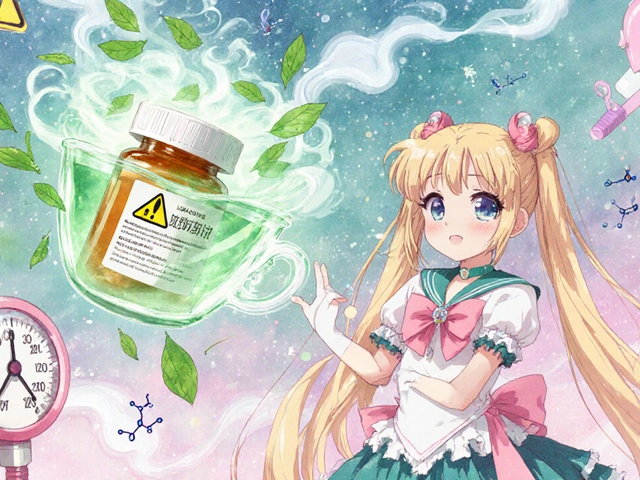Many people take proton pump inhibitors (PPIs) to manage heartburn, acid reflux, or ulcers. These drugs - like omeprazole, esomeprazole, and lansoprazole - work by shutting down the stomach’s acid production. They’re effective, widely prescribed, and often taken for months or even years. But there’s a quiet concern growing in the medical community: long-term PPI use might be linked to weaker bones and a higher chance of breaking a hip, spine, or wrist. It’s not a guarantee. It’s not even a big risk for most people. But if you’re over 65, on high doses, or taking PPIs for more than a year, you need to understand the connection - and what to do about it.
How PPIs Might Weaken Your Bones
It sounds counterintuitive. If your stomach isn’t producing enough acid, how does that affect your bones? The answer lies in calcium. Most calcium supplements - especially calcium carbonate - need stomach acid to dissolve and be absorbed. Without enough acid, your body can’t grab the calcium it needs to rebuild bone tissue. Over time, this can lead to lower bone density. It’s not that PPIs directly destroy bone. It’s that they make it harder for your body to maintain it.
There’s more to it than just calcium. Long-term PPI use can cause your body to produce extra gastrin, a hormone that signals acid production. Higher gastrin levels might trigger changes in bone cells, speeding up the breakdown of bone while slowing down new bone formation. Some research also suggests PPIs could interfere with how your body uses vitamin B12 and magnesium - both important for bone strength. But the strongest evidence points to calcium absorption as the main issue.
The Evidence: Real Numbers, Real Risk
Studies don’t say PPIs cause osteoporosis. They say they increase fracture risk - especially in certain groups. A 2019 meta-analysis published in the Journal of Bone and Mineral Research looked at over 20 studies and found that people taking PPIs for more than a year had a 20-30% higher chance of breaking a hip or spine. That doesn’t mean 1 in 3 people will break a bone. It means if your baseline risk is 2%, it might go up to 2.4%-2.6%. That sounds small, but for older adults, even a small increase matters.
Here’s what the data shows:
- People on high-dose PPIs (like 2 or more pills a day) had a 67% higher risk of hip fracture compared to non-users.
- Those taking PPIs for 7+ years had more than 4 times the risk of hip fracture compared to those who never used them.
- Postmenopausal women had a 35% higher risk of hip fracture with long-term use.
- Fracture risk rose with dose and duration - more pills, longer time = higher risk.
Compare that to H2 blockers (like famotidine or ranitidine), which also reduce acid but don’t seem to carry the same fracture risk. One large 2020 study found PPI users had a 27% higher risk of hip fracture than H2 blocker users - even after adjusting for age, smoking, and other factors.
Who’s Most at Risk?
Not everyone on PPIs needs to worry. The risk is concentrated in specific groups:
- People over 65
- Women, especially after menopause
- Those with low body weight (under 125 lbs)
- People with a history of fractures
- Those taking corticosteroids (like prednisone) or other bone-weakening drugs
- Anyone taking PPIs at high doses for more than a year
If you fit into one or more of these categories and have been on PPIs for over a year, it’s time to talk to your doctor. The risk isn’t just about your bones - it’s about how long you’ve been on the drug, how much you’re taking, and whether you still need it.

Is the Risk Real? The Debate
Not all studies agree. A 2010 study by Dr. Leslie Targownik found no link between PPIs and bone loss in people without other risk factors. The FDA reviewed seven studies in 2010 and concluded the risk was “modest.” The American Gastroenterological Association says the benefits of PPIs usually outweigh the risks - if you’re using them correctly.
But here’s the problem: many people take PPIs long-term without a clear reason. A 2017 study found that 60-70% of PPI prescriptions are inappropriate. People take them for mild heartburn, stop eating spicy food, and never stop the pill. That’s where the real danger lies - not in the drug itself, but in unnecessary, prolonged use.
What You Can Do: Practical Steps
If you’re on PPIs and worried about your bones, don’t stop cold turkey. Acid rebound can make symptoms worse. Instead, take these steps:
- Ask if you still need it. Can you cut the dose? Try taking it every other day? Use it only when symptoms flare up?
- Switch to calcium citrate. If you’re taking calcium supplements, choose calcium citrate instead of calcium carbonate. It doesn’t need stomach acid to absorb.
- Get enough vitamin D. Aim for 800-1000 IU daily. Your body needs it to use calcium properly.
- Get a bone density test. If you’re over 65, female, or have other risk factors, ask your doctor for a DEXA scan. It’s quick, painless, and tells you if your bones are thinning.
- Move your body. Weight-bearing exercise - walking, lifting weights, dancing - strengthens bones. Even 30 minutes a day helps.
- Avoid smoking and too much alcohol. Both hurt bone health and make PPI-related risks worse.
The Endocrine Society and the American Geriatrics Society both recommend that long-term PPI users with risk factors get screened for bone loss. If your bone density is low, your doctor might prescribe a medication like alendronate or denosumab to protect your bones - even while you’re still on PPIs.

Alternatives to PPIs
Not everyone needs a PPI. For mild GERD, lifestyle changes can work:
- Eat smaller meals
- Avoid eating 3 hours before bed
- Elevate the head of your bed
- Lose weight if you’re overweight
- Limit caffeine, alcohol, chocolate, and fatty foods
For occasional heartburn, antacids (like Tums) or H2 blockers (like Pepcid) are safer short-term options. H2 blockers don’t carry the same fracture risk as PPIs. If you need daily acid control, ask your doctor if an H2 blocker might work for you - especially if you’re older or have other bone risks.
The Bottom Line
PPIs are powerful tools. For someone with a bleeding ulcer, Barrett’s esophagus, or severe GERD, they can be life-saving. But for millions of people taking them for mild, occasional heartburn? The risks may outweigh the benefits.
The fracture risk isn’t huge - but it’s real, especially for older adults on high doses for years. The good news? You can reduce or eliminate that risk without giving up relief. Work with your doctor to find the lowest effective dose. Test your bone density if you’re at risk. Switch to calcium citrate. Get moving. And most importantly - ask if you still need the pill.
Medication isn’t always a lifelong commitment. Sometimes, it’s just a bridge. And if your bridge has outlived its purpose, it’s okay to step off.
Do all PPIs increase fracture risk the same way?
Yes, the fracture risk appears to be a class effect - meaning all proton pump inhibitors (omeprazole, pantoprazole, lansoprazole, esomeprazole, etc.) carry similar risks when used long-term and at high doses. The mechanism - reduced stomach acid affecting calcium absorption - is the same across the class. There’s no evidence that one PPI is safer than another for bone health.
Can I take calcium supplements while on PPIs?
Yes, but choose calcium citrate, not calcium carbonate. Calcium carbonate needs stomach acid to dissolve, which PPIs reduce. Calcium citrate doesn’t need acid and is absorbed just as well, even with reduced stomach acidity. Take it with food to improve absorption, and aim for 1,000-1,200 mg daily if you’re over 50.
How long do I need to be on PPIs before fracture risk increases?
Studies show risk starts to rise after about 1 year of daily use. The risk climbs significantly after 3-5 years, and becomes much higher after 7+ years. However, even short-term use at high doses (2 pills a day or more) can increase risk. If you’ve been on PPIs for over a year, it’s time to review your need for them with your doctor.
Should I get a bone density scan if I’m on PPIs?
If you’re over 65, a woman, have a history of fractures, or take PPIs at high doses for more than a year - yes. The Endocrine Society recommends a DEXA scan for long-term PPI users with additional risk factors. Even if you’re younger, if you’ve been on PPIs for 5+ years and have other bone risks, ask your doctor about testing.
Are there any natural ways to reduce stomach acid without PPIs?
Yes. Lifestyle changes can be very effective: eat smaller meals, avoid lying down after eating, lose weight if needed, cut back on alcohol and caffeine, and avoid trigger foods like spicy or fatty meals. Elevating the head of your bed by 6-8 inches helps prevent nighttime reflux. For occasional symptoms, antacids or H2 blockers like famotidine are safer alternatives.






Comments
Esperanza Decor
November 12, 2025 AT 11:44 AMI’ve been on omeprazole for three years for silent reflux, and I never connected it to my hip pain. Last month I got a DEXA scan-T-score of -2.8. My doctor said it was likely PPI-related. I switched to calcium citrate, cut my dose in half, and started walking daily. My bones aren’t fixed, but they’re not crumbling anymore. If you’re on long-term PPIs, get tested. It’s not fear-mongering-it’s just smart.
Deepa Lakshminarasimhan
November 14, 2025 AT 00:44 AMThey’re lying. PPIs don’t cause bone loss. The pharmaceutical companies made up the risk so they could sell you expensive bone drugs. They’ve been doing this since the 80s with statins and now they’re doing it again. Your doctor’s just a paid shill. Check the FDA’s own documents-they admit the link is ‘modest.’ That’s code for ‘we don’t care.’
Erica Cruz
November 14, 2025 AT 22:46 PMUgh. Another ‘PPIs are dangerous’ post. This isn’t science-it’s fear porn. The absolute risk increase is less than 1%. You’re more likely to die from slipping in the shower than from a PPI-induced fracture. People panic over numbers they don’t understand. If you’re 70 and on PPIs for GERD, you’re already at high fracture risk from age, low vitamin D, and being sedentary. Blame the lifestyle, not the pill.
Johnson Abraham
November 15, 2025 AT 19:46 PMbro i been on nexium for 5 yrs and my bones feel fine. u just need to take tums like every day. also vitamin d is fake anyway. i got my bones from lifting weights and drinking coke. lol
Shante Ajadeen
November 17, 2025 AT 00:52 AMThis was super helpful. I’m 68 and on pantoprazole for heartburn. I never thought to question it. I’m scheduling a DEXA scan next week and talking to my doc about switching to calcium citrate. Also, I’m going to start walking my dog twice a day. Small changes, but I feel like I’m taking back control.
dace yates
November 18, 2025 AT 20:45 PMDoes anyone know if the fracture risk is the same for people who take PPIs only 3-4 times a week instead of daily? I take mine only when I’ve had a heavy meal or alcohol.
Danae Miley
November 19, 2025 AT 03:09 AMThe meta-analysis cited in the post used a 95% confidence interval that included zero for low-dose, short-term users-meaning no statistically significant risk. Yet every single comment here is acting like PPIs are a death sentence. This is exactly why evidence-based medicine is under attack: people misinterpret relative risk as absolute risk and panic. Read the actual studies before you repost fear.
Charles Lewis
November 20, 2025 AT 06:08 AMIt is important to recognize that while the data suggests a modest elevation in fracture risk associated with long-term proton pump inhibitor usage, the broader context of geriatric health must be considered. The elderly population, particularly postmenopausal women, are already at elevated risk for osteoporosis due to hormonal changes, decreased physical activity, and often inadequate nutritional intake. The contribution of PPIs to this multifactorial problem should not be overstated, but neither should it be ignored. A prudent approach involves individualized risk-benefit analysis, with emphasis on non-pharmacological interventions such as dietary calcium, vitamin D sufficiency, and weight-bearing exercise. The goal is not necessarily to discontinue PPIs in all cases, but to ensure that their use is both necessary and optimized within a comprehensive bone health strategy.
Renee Ruth
November 21, 2025 AT 19:15 PMMy aunt died last year after breaking her hip on PPIs. She was 72. They told her it was ‘just aging.’ But her doctor never mentioned the risk. She was on it for 8 years. Now my mom’s on it too. I’m begging her to stop. This isn’t just ‘risk.’ This is a silent killer no one talks about. Why isn’t the FDA forcing warning labels? Why are doctors still prescribing this like candy?